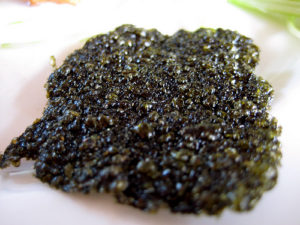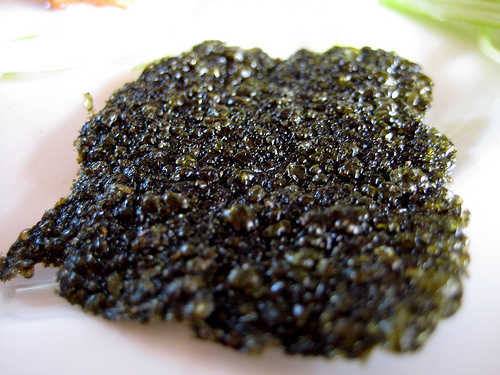 Short Answer:
Short Answer:
Yes, Seaweed is Paleo!
Neither a Vegetable nor Fruit
Seaweed belongs to the group of marine algae. Edible seaweed typically comes in three varieties: brown, green and red seaweeds. The most commonly eaten seaweeds are the brown ones which include kelp and wakame and then the red one which is nori.
While it is often called as sea vegetable, it is neither a vegetable nor fruit. Seaweed is consumed mainly by people living near the coastal area. It is most abundant in Asia and popular in Japanese, Korean and Chinese dishes but has been popular and made its way to other cuisines such as American and European.
Interestingly, seaweed can be a good alternative to salt and can also add flavor to a dish.
Types of Seaweeds
There are three main varieties of seaweed namely red, brown and green. There are more than 200 types and the popular ones are listed below:
Nori
The most popular type of the red algae, nori is a traditional food used to make sushi. It is the mildest form of seaweed, and comes in roasted sheets or squares. Compared to all the other seaweed, nori is fairly low in minerals and other nutrients but it is definitely far from nutrient-deficient. Nori can be a good source of vitamins B and C with fair amount amounts of zinc and iron.
Kelp
Kelp is the most readily available type of edible seaweed. Kombu and wakame are the popular forms of edible kelp on Asian countries. It is normally found in dried form and soaking it makes it edible. Kelp cna also come in granulated formas salt replacement. A quarter teaspoon of kelp can give plenty of iodine.
Kombu
Kombu is a type of edible kelp. It is a brown algae which is widely sold and eaten in Japan. It is usually sold in dried pieces. Kombu is an all purpose seaweed and is most regularly used for soups and sashimi.
Wakame
Wakame is another popular edible type of kelp seaweed and is served as a luxury food on Japanese and Korean restaurants. It is highly sought after bean-curd soup or salads. Wakame appears in miso soups and other simple broths. It has the same nutrient composition as kombu and other kelps in terms of iodine, magnesium and calcium.
Arame
Another type of edible kelp is Arame. It is primarily used in Japanese, Chinese, and Korean cuisines but can also be found in Peruvian and Indonesian dishes. Arame has a sweet, mild flavor.
Dulse
Another type of red seaweed is Dulse. It has less iodine (by most accounts, about 1/5 of the amount) than kombu, with high amounts of magnesium and calcium. It’s often shredded, dried, and sprinkled on soups, but fresh dulse can be sautéed with butter and garlic, or rubbed with olive oil and salt and roasted in the oven to make chips. Dulse also comes in flakes, similar to granulated kelp.
Irish Moss
Also known as carrageen moss, Irish moss grows along the rocky Atlantic coasts of Europe and North America. When heated in liquid, It softens into a jelly-like substance. The Irish and Scottish boil Irish moss to make a tapioca-like pudding dessert. Irish moss is high in iodine, magnesium, calcium, manganese, zinc and bromine.
Alaria Esculenta
Alaria Esculenta is a traditional seaweed found in the far north Atlantic Ocean, Greenland, Iceland, Scotland, and Ireland. It is a brown seaweed with a large central rib, from which wavy membranes shoot out on either side. Alaria was traditionally dried, then added to soups and stews. Alaria Esculenta is also called dabberlocks, badderlocks, or winged kelp.
Laver
Laver is an edible seaweed used to make laverbread. It is commonly found in the west coast of Great Britain and east coast of Ireland.It has smooth texture.Laver has high content of dietary minerals specifically iodine and iron.
Nutritional Value of Seaweed
Seaweed is one of the most nutritionally dense plant-food sources in the planet. It draws an extraordinary wealth of mineral elements from the sea. These minerals include iodine, sodium, calcium, magnesium, potassium, sulfur, iron, zinc, copper, selenium, manganese, riboflavin, pantothenic acid and phosphorus. They are made available through colloidal form which means they are small enough to be absorbed by the body easily.
Among all the edible creatures living in the water, seaweed has the largest proportion of iodine. It is also one of the richest plant sources of calcium. Its calcium content is exceptionally higher than beef and broccoli. Vitamins such as Vitamin A, B, C and E are also present in seaweed. Specifically, seaweed has high levels of folic acid or B9 which are important in preventing birth defects and other cardiovascular diseases. It is also one of the known non-meat source of vitamin B12 which helps in metabolizing fats for energy.
Health Benefits of Seaweeds
Seaweed is packed with high amounts of vitamins and minerals and has a lot of significant benefits to offer:
- A gram of seaweed can provide a sufficient daily dose of iodine which is critically important in maintaining healthy thyroid function. Iodine is a nutrient which is not commonly present in other food sources.
- Lignans are plant compounds present in seaweed that have anti-cancer properties. They are thought to prevent formation of cancerous tumors.
- Seaweed helps in regulating and purifying the blood system. It helps alkalize and neutralize the blood and protect the body from toxic elements. This is because seaweed’s chemical composition is so close to human blood plasma.
- Seaweed has a remarkable effect on weight loss and cellulite build up. The concentrated amount of natural iodine in seaweed helps stimulate the thyroid gland so that food fuels are used before they can be turned into fatty deposits. The minerals on the other hand act like electrolytes. They break the chemical bond that seals the fat cells allowing trapped wastes to escape.
- Sea vegetables contain alginic acid, a compound that removes radioactive isotopes and other heavy metals from the digestive tract. Hence, promoting, healthy digestive system.
- Seaweed has compounds that can help regulate estrogen and estradiol levels. These hormones are essential in the proper development and function of sexual organs.
Seaweed and Heavy metals
Seaweeds are frequently recommended because of their incredible health benefits. But because seaweeds can soak up all the beneficial nutrients in the water, it is possible that it can also absorb toxins such as mercury, arsenic and lead which can make them unsafe to eat. There are no studies yet that justify toxicity over seaweed consumption except from black algae known as hijicki. It has shown to possess high levels of heavy metals especially arsenic and mercury. If you are hesitant to eat seaweeds because of possible heavy metal accumulation, you can always seek organic ones to make sure they are safe to consume and definitely avoid hijicki.
What Experts Say About Seaweed
“Mimicking the mineral content of the ocean – which incidentally mimics the mineral content of human blood – sea vegetables are, pound for pound, the most nutrient dense food in existence”. – Mark Sisson
Other Names for Seaweeds
Sea vegetables
All you ever wanted to know about Seaweed and Paleo
Mark’s Daily Apple. A Visual Guide to Sea Vegetables
http://www.marksdailyapple.com/a-visual-guide-to-sea-vegetables/#axzz3PCXUoyhf
Mark’s Daily Apple. Smart Fuel: Sea Vegetables
http://www.marksdailyapple.com/sea-vegetables-2/#axzz4EjrOMES8
The Paleo Diet. Seaweed Trail Mix
http://thepaleodiet.com/seaweed-trail-mix/
The Paleo Mom. Why Seaweed is Amazing!
http://www.thepaleomom.com/why-seaweed-is-amazing/
Paleo Porn. Is Seaweed Paleo?
http://paleoporn.net/q/is-seaweed-paleo/
Paleo Porn. Is Nori Paleo?
http://paleoporn.net/q/is-nori-paleo/
Seaweed & Co. Seaweed – The Ultimate Paleo Food?!
http://www.seaweedandco.com/seaweed-benefits-paleo/
The Kombu Seaweed Blog. Paleo Diet and Kombu Seaweed
http://www.kurakonusa.com/blog/2012/11/paleo-diet-and-kombu-seaweed/
Paleo Diet News. The Paleo Diet and Superfoods – Part 3: Seaweed and Herbs
http://paleodietnews.com/4805/the-paleo-diet-and-superfoods-part-3-seaweed-and-herbs/
Livestrong.com. What are the Health Benefits of Eating Seaweeds?
http://www.livestrong.com/article/18578-health-benefits-eating-seaweed/
NCBI. Skibola, C.F, Curry, JD, Vandevoort C, Conley A, Smith MT. Brown kelp modulates endocrine hormones in female sprague-dawley rats and in human luteinized granulosa cells.
http://www.ncbi.nlm.nih.gov/pubmed/15671230
Did we miss anything?
Comment below and let us know what you think. Do you agree with our conclusion?
photo credit: Thick snack nori

